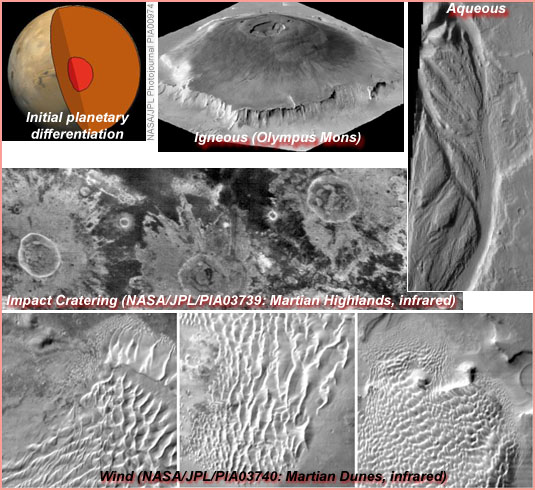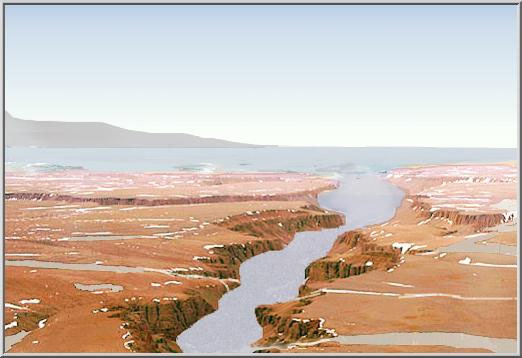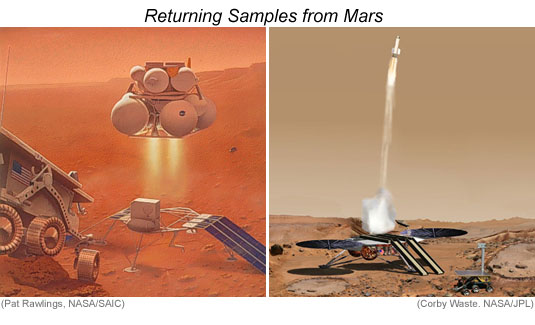|
|
|
|
|
|
|
Magma and Water on Mars--- Martian meteorites tell us part of the fascinating story about when volcanoes erupted and water flowed.
Written by G. Jeffrey Taylor |
 |
Reference:
What Happened When?
Planetary scientists focus their attention on what geologic events shaped a planet, the relative sequence of events, and the absolute ages of those events. What happened? When did it happen? In the case of Mars, there are five major processes that manufactured its crust. One is the initial melting that formed a metallic core, primitive mantle, and initial crust above the mantle. This fundamental event involved assembling the planet from smaller planetesimals, widespread melting of the planet, and differentiation into its major zones. The second major process involves subsequent melting to produce a series of igneous rocks over billions of years. Some of the magmas erupted onto the surface; others were trapped in the crust to form what geologists call "intrusive" or "plutonic" rocks. The third major process involves water that carved channels and drainage networks, chemically reacted with the igneous rocks making up the crust, and transported sediments for deposition in low areas. The fourth process is impact. This was much more enthusiastic early in the history of the Solar System. In fact, the inner planets were assembled by planetesimals whacking into each other. Most of the craters in the ancient highlands of Mars were formed by high-velocity impacts of objects onto Mars. The final process is erosion and redistribution by wind, which may be the most important process now operating on the Red Planet.
 |
| Processes that have shaped the Martian surface: initial planetary differentiation, igneous, aqueous, impact, wind. |
Lars Borg and Mike Drake focus on the first three processes, with emphasis on the igneous and aqueous history of Mars. Their synthesis of age data allows us to divide Mars into broad age brackets on the basis of meteorite data.
Planet Construction Events
Cosmochemists can determine when a metallic core formed on Mars by measuring the isotopic abundances of hafnium (Hf) and tungsten (W). The short-lived isotope 182Hf decays into 182W. Because 182Hf has a half life of only 9 million years, it has very good time resolution for the early solar system. Furthermore, if metallic iron is present when a planet melts, tungsten concentrates in it, leaving behind a molten silicate mantle with very little tungsten, but the original amount of hafnium. If core formation took place while 182Hf was still around, 182W would build up in the rocky portion, allowing a measurement of when the metal separated from the silicate--the time of core formation. For more gory details, see PSRD article Hafnium, Tungsten, and the Differentiation of the Moon and Mars.
The most recent measurement of the time of core formation was reported by Nicole Foley and colleagues (including Lars Borg). From hafnium and tungsten isotopes in Martian meteorites, Foley calculates that the Martian core formed 4556 (± 1) million years ago. That is no more than 12 million years after formation of the oldest objects in the Solar System, the calcium-aluminum rich inclusions in chondrites.
After the metallic core formed, it may have taken a while for the surrounding molten or partly molten silicate (the primitive mantle) to solidify. How long that took is recorded, ironically, in the youngest Martian meteorites, the shergottites. Shergottites are basaltic rocks that formed as lava flows. In a paper published in 2003, Borg and his colleagues showed that the regions in the mantle that gave rise to the shergottites formed 4513 (± about 30) million years ago.
Borg realized he could use both the long-lived and short-lived samarium (Sm) isotopes to define the age of the shergottite mantle sources by using three parameters to assess the age of differentiation of shergottite mantle sources. One is the initial ratio of neodymium-143 to neodymium-144 (143Nd/144Nd) in each shergottite, expressed as ε-143Nd, a measure of how the ratio deviates from the ratio in chondritic meteorites, in parts per ten thousand. 147Sm decays to 143Nd with a long half-life of 106 billion years. The other is the initial ratio of 142Nd/143Nd, or ε-142Nd, the deviation of the ratio from chondritic meteorites, again in parts per ten thousand. 142Nd is produced by the decay of 146Sm, which has a half life of only 103 million years. He also needed to know the ratio of 147Sm/144Nd in the source regions. Borg knew he could calculate lines of equal age (isochrons) for different times if he assumed three things: (1) the epsilon (ε) values were initially like those in chondrites, (2) formation of the sources involved formation of reservoirs with different Sm/Nd ratios, and (3) the sources melted only once more (when each shergottite magma formed). By plotting data from shergottites on the resulting complicated graph, Borg hoped to find the age of mantle differentiation. Adding new results obtained by Nicole Foley produces a slightly revised age of 4526 ± 20 million years.
 |
Assuming that the parts of the Martian mantle formed early and remained unmelted until formation of the magmas that gave rise to the shergottites, Lars Borg showed that the shergottites lie on a single line that indicates formation of at least portions of the Martian mantle 4526 (± 20) million years ago. |
Taken at face value, it appears that the Martian core formed 30 million years before the overlying silicate mantle solidified (4556 My for core formation, 4526 for formation of the shergottite source regions in the mantle). However, Maud Boyet and Richard Carlson (Carnegie Institution of Washington) have made improved measurements of the ratio of 142Nd to 144Nd in chondrites, the basis for Sm-Nd age dating. They found that this ratio in chondrites is 20 parts per million lower than assumed previously. While not sounding like a big number, it translates to a big change in the estimate of the time of mantle formation on Mars. No detailed calculations have been reported, but it is possible that the time of mantle formation coincided with the time of core formation. Boyet and Carlson's result is new and its full ramifications are being explored by cosmochemists.
Early Crustal Events
One of the most famous Martian meteorites is also the oldest, ALH 84001 [Data link from Meteoritical Database]. This meteorite is notorious for the proposed presence of tiny fossils and other biomarkers (see PSRD article Life on Mars?). While the debate about fossils in the rock has died down (with most investigators concluding that there are other explanations besides biology for the array of features in the rock), cosmochemists are paying more attention to how the original igneous rock formed. Larry Nyquist (Johnson Space Center) and coworkers found that the rock crystallized from a magma 4500 (± 130) million years ago. It must have formed in a body of magma intruded into the crust because it is composed mainly of one mineral, orthopyroxene. Such one-mineral rocks are called "cumulate" because they form by accumulation of minerals in a buried magma body.
 |
 |
LEFT: Large crystals of orthopyroxene in ALH 84001 show that this rock formed in an underground magma chamber on Mars. Dark areas are chromite (an oxide of chromium and iron). RIGHT: ALH 84001 formed about 4.5 billion years ago in a relatively large magma body inside the crust of Mars. Its high abundance of one mineral (orthopyroxene) indicates that this mineral must have accumulated in the magma, probably near the bottom of the magma body, eventually forming the original igneous rock with large crystals of orthopyroxene. | |
ALH 84001 contains intricate deposits of carbonate minerals. They reside in a variety of settings and textures, from interstitial crack fillings to conspicuously zoned clusters, semi-circular in cross-section, which have gotten the name "rosettes." (See PSRD article Carbonates in ALH 84001: Part of the Story of Water on Mars.) These assemblages are quite complicated. Carbonate compositions vary widely and they contain small grains of magnetite and sulfides. It would seem to be impossibly challenging to determine their age, but Lars Borg and colleagues at the Johnson Space Center managed to painstakingly separate different mineral phases by differential dissolution and then measured the isotopic composition of rubidium and strontium in the rock. The resulting Rb-Sr age is 3900 ± 40 million years. They also measured the age using lead isotopes, which gave the same value within experimental uncertainty, 4040 ± 100 million years. Apparently the carbonates precipitated from water that had soaked the rock about 3900 million years ago, showing that water could flow through the rock for at least a short time. Curiously, the rock has been bone dry since.
Borg and Drake summarize intriguing research done by Don Musselwhite and Mike Drake on understanding the ratio of xenon-129 to xenon-132 (129Xe/132Xe) in the Martian atmosphere compared to Martian basalts. 129Xe is the decay product of another of those short-lived isotopes, in this case iodine-129. 129I has a half life of 16 million years. The Martian atmosphere has a high ratio of 129Xe/132Xe (2.4) compared to Martian meteorites (1.0 to 1.5). This indicates that early in Martian history iodine was separated from xenon. This had to happen before the radioactive 129I had decayed away, about 100 million years after synthesis of 129I in an exploding star before the Solar System formed.
Borg and Drake summarize mechanisms for how iodine and xenon can be separated, concluding that the most promising involves water. Iodine is much more soluble in water than is xenon; in fact, it is 100 billion times more soluble. After initial differentiation is complete, iodine and xenon are driven from the interior by volcanism. If widespread bodies of water were present (oceans or big lakes), the iodine would dissolve in the water, leaving xenon in the atmosphere. Large impacts may have driven off this initial atmosphere, xenon included. The iodine remains in solution in the water. The water reacts with crustal rocks and drains inside the upper layers of the crust, and the 129I in it continues to decay, forming 129Xe and giving the rocks a high ratio of 129Xe to 132Xe. With time, the Xe is released into the atmosphere, giving a high 129Xe/132Xe ratio. If correct, this story implies that there was water present on the Martian surface soon after formation of the core and mantle.
 |
If oceans and other large bodies of water existed very early in Martian history, iodine released from erupting magma might have dissolved in them, thereby separating iodine from xenon. Painting courtesy of NASA. |
The Billion Year-Plus Club
One group of seven Martian meteorites, the nakhlites, has an age of 1327 ± 39 million years. These are unusual lava flows in which pyroxene has accumulated. They also contain olivine, plagioclase feldspar, glass, calcium phosphates, and magnetite as igneous minerals. They might not all have formed at exactly the same time because their ages range from 1260 to 1370 million years, but they clearly represent a region of Mars that was volcanically active 1300 million years ago.
 |
Photomicrograph of a thin section of the Nakhla meteorite, viewed in polarized light. Blue and reddish crystals are olivine. All the others are high-calcium pyroxene (augite). [Data link from Meteoritical Database] |
An interesting problem is the lack of meteorites between 1300 and 4500 million years old, in spite of much of the crust of Mars being constructed during that time. This may simply reflect how the meteorite delivery process (large impacts) samples the Martian surface and when it does so. For example, if an impact into a region of Mars dominated by rocks 3000 million years old took place 500 million years ago, or even 100 million years ago, the meteorites sent flying from Mars might have been swept up by the Earth and other planets long ago. Once on Earth, they would weather away or be buried, unavailable to us now.
The nakhlites also contain minerals formed by reaction with water. These include carbonates, sulfates, clay minerals, and iron oxides. One common form is called iddingsite, which contains clays, and assorted hydrated and not hydrated iron oxides (magnetite, maghemite, and ferrihydrite), all of which are common products of rock weathering. The weathering products typically form veins inside the meteorites, not unlike what happens during the initial stages of weathering of rocks on Earth, but usually make up about 1% of the rocks.
 |
Julie Stopar (University of Hawaii) created this mineral map of a thin section of the MIL 03346 nakhlite [Data link from Meteoritical Database]. Colors correspond to different minerals. Most are igneous, but veins of altered rock (blue in the map) and patches of sulfate minerals (red) occur. The alteration zones are like those dated in other nakhlites. |
 |
Alteration vein (reddish brown) inside an olivine crystal in MIL 03346 nakhlite is composed of weathered olivine with sulfur (S) and chlorine (Cl) added. |
Age dating experts at the Johnson Space Center and the University of Arizona attempted the very difficult task of dating the products of aqueous alteration. The Johnson Space Center group did differential dissolution experiments to get at least two points on a rubidium-strontium diagram. The resulting ages were 614 to 679 million years. The Arizona group tried to use potassium-argon dating. They found a wide range in ages, from about 100 to 670 million years. Those less than 600 million years might have lost argon because of heating, perhaps when the meteorites were blasted off Mars. The best guess for the age of alteration in the nakhlites is 633 ± 23 million years.
Rock Youngsters
The youngest Martian meteorites are basaltic rocks that formed in lava flows, the shergottites. They consist of pyroxene (two types, pigeonite and augite), plagioclase feldspar (transformed by impact into a glass), and assorted accessory minerals. They are the most abundant Martian rocks in our collections on Earth.
 |
Tara Hicks-Johnson (University of Hawaii) created this mineral map of a thin section of the Shergotty Martian meteorite [Data link from Meteoritical Database]. It consists mostly of pyroxene and plagioclase feldspar, the main minerals in planetary basalts. |
The shergottites range in age from 165 to 575 million years old. However, there are clear groupings of ages: 575 My, 474 My, 332 My, and 175 My. Considering the poor sampling of Mars that meteorites give us, this indicates quite a bit of recent volcanism. Equally important, isotopic measurements determine the initial ratio of strontium-87 to strontium-86 (87Sr/86Sr) in the lava flows, which is a fingerprint of the chemical characteristics of the places in the mantle that melted to make the magmas. These studies indicate that the 10 shergottites in the 175 My group represent no fewer than 10 separate regions in the mantle, hence 10 separate melting events. If we take the full range of apparent ages, the maximum time over which these basalts erupted is 42 million years. That translates to one eruption every 4.2 million years. If the spread in ages is represented by the standard deviation of the average in the ages, 4 million years, then there is an eruption every 0.4 million years. Not too active by terrestrial standards, but considering sampling biases, it shows clearly that Mars was volcanically active within the past 175 million years, suggesting there could be some activity very recently.
All the shergottites contain the products of aqueous alteration, including sulfates and carbonates. They are very low in abundance, and no direct age determinations have been made on them. However, they occur in rocks that are all younger than 575 million years, many 175 million years old, so the aqueous alteration must have occurred during the past 175 million years. Hence, there is recent volcanism on Mars and recent aqueous alteration. Water may not be flowing across the dusty surface as vigorously as it did billions of years ago, but there is enough of it around to react with basalts, at least in some places.
More Datable and Partly Rotted Rocks Await Us on Mars
The meteorite research Lars Borg and Mike Drake summarize shows the value of being able to look closely at rocks, identify igneous and alteration minerals in them, and to make painstaking isotopic measurements and age determinations. The only drawback is that the meteorites do not contain the complete story. There might be a bias in how rocks are blasted off Mars and delivered to us stuck here on Earth. Rocks that have been extensively altered by water might not be able to survive such a violent launch process. Meteorites from the large area with ages between 1300 and 4500 million years might not have been sent our way at the right time that we find them on Earth now. We need more samples.

|
|
[ About PSRD |
Archive |
Search |
Subscribe ] [ Glossary | General Resources | Comments | Top of page ] |